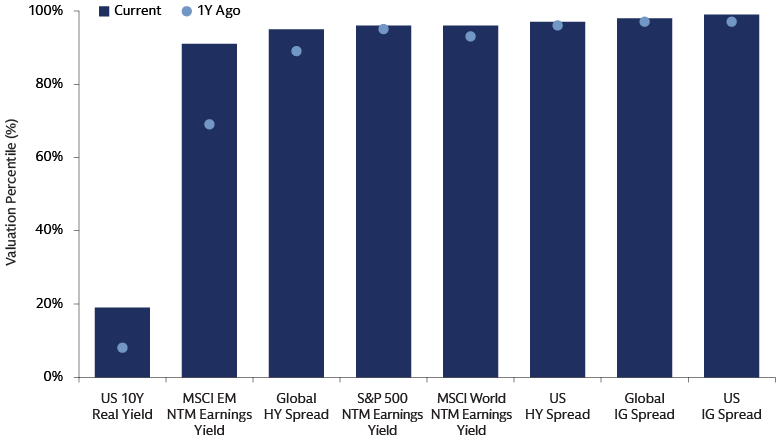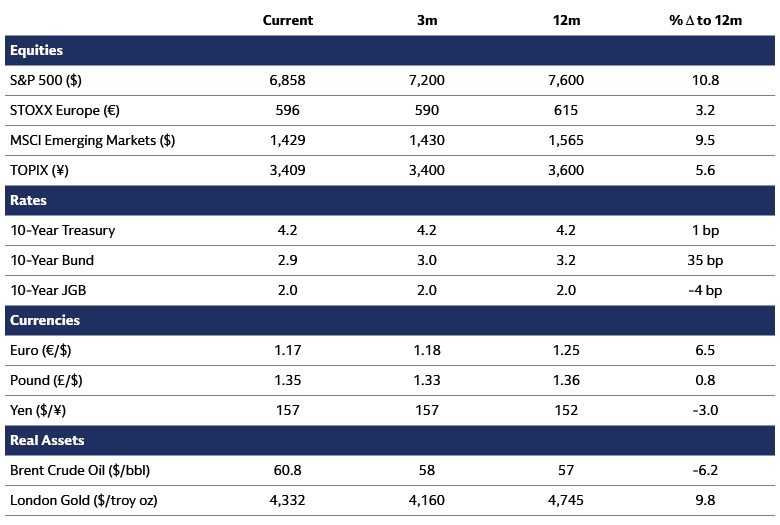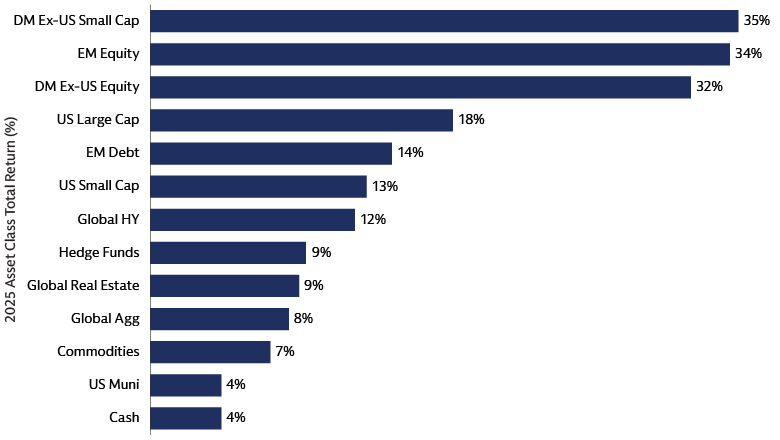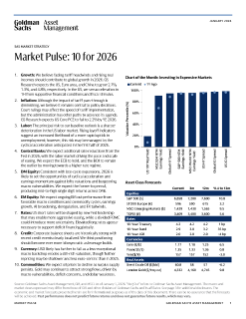Market Pulse: 10 for 2026
We believe fading tariff headwinds and rising real incomes should contribute to global growth in 2026. Goldman Sachs Global Investment Research expects the US, Euro area, and China to grow 2.7%, 1.3%, and 4.8%, respectively. In the US, we see acceleration in 1H from supportive financial conditions and fiscal stimulus.
Although the impact of tariff pass-through is diminishing, we believe it remains central to policy decisions. Court rulings may affect the speed of tariff implementation, but the administration has other paths to advance its agenda. GS Research expects US Core PCE to fall to 2.2% by YE 2026.
The principal risk to our baseline outlook is a sharper deterioration in the US labor market. Rising layoff indicators suggest an increased likelihood of a more rapid uptick in unemployment; however, this risk may be managed by the cyclical acceleration anticipated in the first half of 2026.
We expect additional rate reductions from the Fed in 2026, with the labor market driving the pace and scale of easing. We expect the ECB to hold, and the BOJ to remain the outlier by moving towards a higher rate regime.
Consistent with late-cycle expansions, 2026 is likely to set the opportunities of cyclical acceleration and earnings momentum against lofty valuations and burgeoning macro vulnerabilities. We expect the former to prevail, producing mid-to-high single digit returns across DMs.
We expect ongoing EM outperformance from favorable macro conditions and commodity cycles, earnings growth, AI broadening, deregulation, and FX tailwinds.
US short rates will be shaped by new Fed leadership that may enable more aggressive easing, while a divided FOMC could introduce more uncertainty. Elevated long rates appear necessary to support deficit financing globally.
Corporate balance sheets are historically strong with recent credit events clearly localized. We think positioning should become ever more idiosyncratic as leverage builds.
USD likely has further to fall as a less-exceptional macro backdrop erodes a still-rich valuation, though further repricing may be shallower and less euro-centric than in 2025.
We expect oil prices to decline as surplus supply persists. Gold may continue to attract strong flows, driven by macro vulnerabilities, deficit concerns, and dollar weakness.

Source: Bloomberg and Goldman Sachs Asset Management. As of January 2, 2026. Valuation percentiles are since 2005, earliest common inception.

Asset Class Forecasts: Price targets of major asset classes are provided by Goldman Sachs Global Investment Research. Source: “Publishing our 2026 Global Macro Outlooks.” As of January 5, 2026.
Diversification: The Comeback Tour
Diversified portfolios outperformed in 2025 as global equities posted double digit gains, with developed markets ex-US and emerging markets outpacing the US for the first time since 2017. In 2026, we expect the equity opportunity set to continue to broaden amid greater dispersion of secular themes, while potential volatility reinforces the importance of diversifying income and risk.

Source: Bloomberg, MSCI, and GSAM. As of December 31, 2025. Chart shows calendar-year returns for key market indices from 2016–2025. US Large Cap refers to the S&P 500 Index, US Small Cap refers to the Russell 2000 Index, Intl Equity refers to the MSCI EAFE Index, US Muni refers to the Bloomberg Barclays Muni Index, Cash refers to the J.P. Morgan 1 Month Cash Index, EM Debt refers to the J.P. Morgan EMBI Global Diversified Composite Index, Global HY refers to the Barclays Global High Yield Index, Global Agg refers to the Bloomberg Global Aggregate Index, EM Equity refers to the MSCI EM Index, Intl Small Cap refers to the S&P Developed Ex-US Small Cap Index, Commodities refers to the S&P GSCI Index, Hedge Funds refers to the HFRI Fund of Funds Composite I Index, and Global Real Estate refers to the GPR 250 REIT Index. This example is for illustrative purposes only to show the performance dispersion between various asset classes over time and the potential importance of diversification. Diversification is the process of allocating capital in a way that reduces the exposure to any one particular asset or risk. Diversification does not protect an investor from market risks and does not ensure a profit. Past performance does not predict future returns and does not guarantee future results, which may vary.
“We/Our” refers to Goldman Sachs Asset Management. The economic and market forecasts presented herein are for informational purposes as of the date of this document. There is no guarantee that objectives will be met. There can be no assurance that forecasts will be achieved. Diversification does not protect an investor from market risk and does not ensure a profit. Please see additional disclosures at the end of this document. Past performance does not predict future returns and does not guarantee future results, which may vary.

